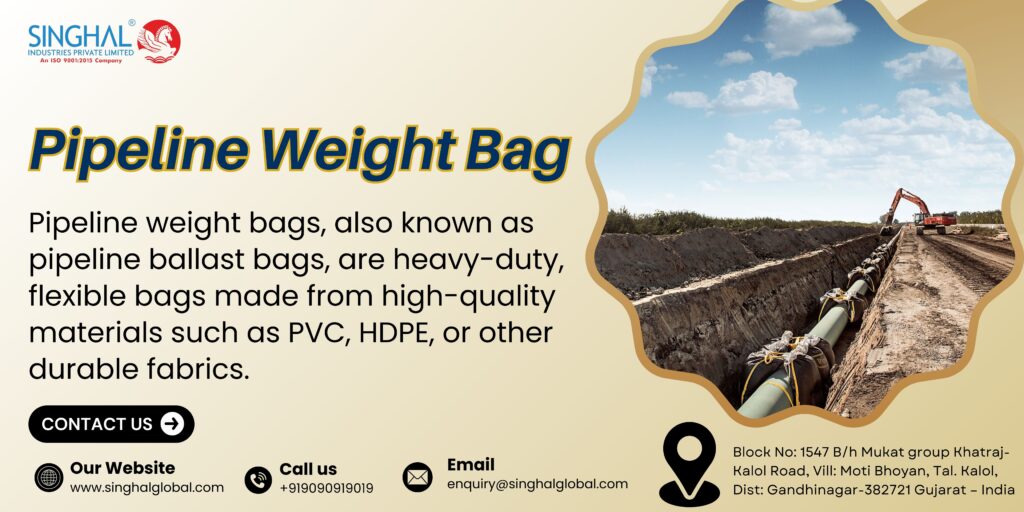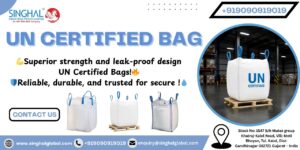Pipeline networks form the foundation stone of modern industrial infrastructure, which enables the transport of natural gas, petroleum, water and other important materials through large distances. Since pipelines are often exposed to rough areas, tough climate and enormous pressure, it is necessary to ensure their integrity for both safety and cost -effectiveness. The most stated of maintaining pipeline stability is the use of the pipeline weight bag in the very effective instrument yet. These weight bags ensure significant support, improve the integrity of pipelines and improve the life of the pipeline network. This weight of the pipeline helps maintain pipeline integrity and long life. Always purchase the Pipeline Weight Bags from trusted Pipeline weight bags manufacturers.
What Are Pipeline Weight Bags?
The purpose of the weight bag for pipelines, also known as anchor bags or ballast bags, is to give weight to a pipeline with the aim of securing it on the ground. Pipeline weight bags are usually filled with a mixture of weighty materials such as concrete, gravel or sand, and they are very effective at stabilizing the pipelines. The gravity of these bags holds the pipeline down, so that it will not float, shift, or buckle under the force of outside movements like water flow, ground displacement, or heat expansion.
Pipeline weight bags are widely applied where the pipeline runs across rivers, lakes, or other water bodies. But they can also be used in areas where pipelines are installed with poor soil conditions or where stability is needed to a high extent to avoid seismic activity or outside pressure damage. Singhal Industries is one of the leading Pipeline weight bags suppliers in the country.
The Role of Pipeline Weight Bags in Improving Integrity
Preventing Pipeline Uplift
One of the key purposes of pipeline weight bags is to avoid pipeline uplift. Uplift takes place when the pipeline is displaced or floated due to water pressure or other forces acting on the pipeline. It is a particular issue for underwater pipelines or for pipelines installed where there is a high water table. If the pipeline is removed or floats away, it will probably experience leakage, structural failure or unusable pipeline.
Set the pressure on this upwards by putting pressure on the pipeline’s weight bag pipeline safely to maintain the position safely. The cancellation is prevented and ensures weight bags that the pipeline retains the desired course and integrity, and reduces the risk of repair expenses and operating closures.
Minimizing Pipe Movement
Geotextile pipeline bag weight also avoid lateral or horizontal movement of the pipeline. Where the soil moves in places like areas of heavy rainfall, flooding, or earthquakes, pipelines are subject to unwanted movement. Minor movement can result in misalignments, putting joints and welds under stress, which may ultimately cause failures.
Through planned positioning of the weight bags at strategic positions around the pipeline, operators will keep the pipeline firm, irrespective of difficult situations. The pressure on the pipeline gets partly dispersed through the force applied by the Geotextile pipeline bag weight in that it gets dispersed rather than destroying delicate elements around the pipe that includes the valve, sealants, and joint areas.
Reducing External Pressure on the Pipeline
Excessive external pressure due to environmental conditions, such as strong water currents or changing soils, can add too high pressure on pipelines. The structural integrity of the pipeline is weakened with constant force over time, causing cracks, dents or other disadvantages. A pipeline weight bag acts as a buffer, which reduces forces that will otherwise hit the pipeline directly.
By distributing the weight of the surface of the pipeline smoother, these bags provide relief from concentrated pressure points. This prevents local load and causes premature wear and tears, so that the pipeline remains strong and flexible in the long term.
Pipeline Weight Bags: Enhancing Longevity
Application of pipeline weight bag provides a strong life of a pipeline. By stabilizing the pipeline and reducing the effect of damage caused by external forces, bags extend the working life to the pipeline, and the pipeline operators save time and money.
Protection against Corrosion
Corrosion is one of the most important dangers in the pipeline, especially in a water struggle or extreme environment. A pipeline can cause abrasive forces with excessive speed or instability that removes protective coating or brings the underlying metal into contact with corrosive substances.
Pipeline weight bags minimize the movement risk, and subsequently, the chances of pipeline abrasion or damage to the protective coatings decrease. There is less friction and movement, reducing the possibilities of corrosion, thus lengthening the pipeline’s lifespan overall.
Enhanced Resistance to Harsh Conditions
The pipes usually have to endure harsh environmental conditions, which include freezing temperature, scorching heat, or even an earthquake. Temperature changes cause these movements of contraction and expansion in the material, resulting in stressing the pipe’s material. If the pipe is anchored in place using weight bags, these kinds of movements of temperature are distributed more effectively without causing the pipe to expand and contract too much.
Reduced Maintenance Expenses
It is an expensive and time-consuming endeavor to keep a pipeline running. Any mishap or dysfunction must be checked, repaired, or even fully replaced, an expensive and inconvientous task. Having pipeline weight bags will decrease overall repair needs as the pipeline would be more supported from damage arising from external causes.
With low pipe movement, regeneration or external pressure, pipeline companies can reduce inspections and repairs that are quite necessary, making it possible to save money. In addition to cost savings for immediate repair, they prevent shutdown, which not only affects production, but also money.
Conclusion
Pipeline weight bags are a simple but effective remedy for improving the integrity and life of the pipeline system. By avoiding lifting, reducing the pipe movement, reducing external pressure and achieving stability in different environmental conditions, weight bags can stabilize pipelines and prevent damage. The benefits of weight bags in the pipeline are widespread and include maintenance expenses, rust prevention and ending of resistance to severe weather and seismic conditions.
As the demand for energy and water increases and pipelines move rapidly forward in the difficult area, the need to use pipeline weight bags to provide stability and safety will only be intensified. As a cost -effective and test method for securing pipelines, the weight bag is an important component for maintaining infrastructure that reduces our modern world.
Frequently Asked Questions (F&Q)
What materials are pipeline weight bags made from?
Pipeline weight bags, or geotextile bags, are usually produced with non-biologically degradable polypropylene fabric and are filled with rocks.
How much weight can a pipeline weight bag support?
Pipeline weight bags with pipeline, or geotextile pipeline weight, can be taken from 100 kg (220 kg) to smaller size for large size to 5670 kg (12,500 pounds) for smaller size.
Are pipeline weight bags resistant to corrosion?
Yes, pipeline weight bags, usually produced using non-bio-degrade polypropylene substances, are corrosion resistant and used to maintain bounce control and shield pipeline coating from damage.
How do pipeline weight bags protect pipelines?
Pipeline weight bags, containing gravel and so forth, give negative buoyancy and stability to pipelines, hindering them from floating or shifting as a result of external forces such as water currents or ground movement, and shielding the pipeline coating from destruction.









